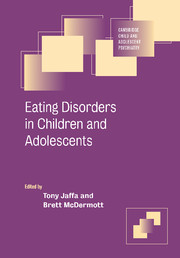Book contents
- Frontmatter
- Contents
- List of Contributors
- Part I Introduction
- Part II Scientific underpinnings
- Part III Abnormal states
- 9 Anorexia nervosa in children and adolescents
- 10 Eating disorders in boys
- 11 Bingeing and bulimia nervosa in children and adolescents
- 12 Selective eating and other atypical eating problems
- 13 Comorbid anxiety and depression and the role of trauma in children and adolescents with eating disorders
- 14 Eating disorders in children with disabilities and chronic illness
- 15 Childhood obesity
- Part IV Evidence-based care
- Part V Public health perspectives
- Index
- References
11 - Bingeing and bulimia nervosa in children and adolescents
from Part III - Abnormal states
Published online by Cambridge University Press: 02 December 2009
- Frontmatter
- Contents
- List of Contributors
- Part I Introduction
- Part II Scientific underpinnings
- Part III Abnormal states
- 9 Anorexia nervosa in children and adolescents
- 10 Eating disorders in boys
- 11 Bingeing and bulimia nervosa in children and adolescents
- 12 Selective eating and other atypical eating problems
- 13 Comorbid anxiety and depression and the role of trauma in children and adolescents with eating disorders
- 14 Eating disorders in children with disabilities and chronic illness
- 15 Childhood obesity
- Part IV Evidence-based care
- Part V Public health perspectives
- Index
- References
Summary
Introduction
The identification of children and adolescents with bulimia nervosa (BN) or syndromes including binge-eating has been an area of development in recent years.
This chapter will review this increasingly important area, providing an overview of the nature of these phenomena, risk factors for their development and the medical complications of these disorders.
Definition
Bulimia nervosa was first described by Russell in 1979, appearing in the Diagnostic and Statistical Manual–III (DSM–III) in 1980. The current diagnostic criteria found in DSM–IV (American Psychiatric Association, 1994) include recurrent episodes of binge eating characterized by eating in a discrete period of time (2 hours or less) an amount that is larger than most people would eat under similar circumstances; a sense of loss of control over eating during a binge episode; as well as, recurrent inappropriate compensatory behaviours in order to prevent weight gain. These compensatory behaviours can include self-induced vomiting, misuse of laxatives, diuretics and other medications, fasting or excessive exercise. The binges and inappropriate compensatory behaviours must occur on average and least twice a week for 3 months. Self-evaluation is unduly influenced by body shape and weight, and the disturbance does not occur during episodes of anorexia nervosa (AN). Bulimia nervosa is typed as either purging, where self-induced vomiting or misuse of laxatives, diuretics and enemas are part of the presentation and non-purging, where these compensatory behaviours do not regularly occur and are replaced by behaviours such as exercising and fasting.
Keywords
- Type
- Chapter
- Information
- Eating Disorders in Children and Adolescents , pp. 133 - 143Publisher: Cambridge University PressPrint publication year: 2006

